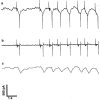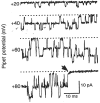Electrophysiological methods
Figures








Similar articles
-
Electrophysiological analysis of neuronal and muscle function in C. elegans.Methods Mol Biol. 2006;351:175-92. doi: 10.1385/1-59745-151-7:175. Methods Mol Biol. 2006. PMID: 16988434 Review.
-
Bridging the gap between genes and behavior: recent advances in the electrophysiological analysis of neural function in Caenorhabditis elegans.Trends Neurosci. 2003 Feb;26(2):90-9. doi: 10.1016/S0166-2236(02)00041-3. Trends Neurosci. 2003. PMID: 12536132 Review.
-
Electrophysiological recordings from the neuromuscular junction of C. elegans.WormBook. 2006 Oct 6:1-8. doi: 10.1895/wormbook.1.112.1. WormBook. 2006. PMID: 18050434 Free PMC article. Review.
-
[Electrophysiological analysis of the cell: patch-clamp recording].Tanpakushitsu Kakusan Koso. 2004 Aug;49(11 Suppl):1628-33. Tanpakushitsu Kakusan Koso. 2004. PMID: 15376987 Review. Japanese. No abstract available.
-
The electrophysiology setup.Curr Protoc Neurosci. 2001 May;Chapter 6:Unit 6.1. doi: 10.1002/0471142301.ns0601s00. Curr Protoc Neurosci. 2001. PMID: 18428508
Cited by
-
Single-Molecule Tracking of Chromatin-Associated Proteins in the C. elegans Gonad.J Phys Chem B. 2021 Jun 17;125(23):6162-6170. doi: 10.1021/acs.jpcb.1c03040. Epub 2021 Jun 7. J Phys Chem B. 2021. PMID: 34097417 Free PMC article.
-
AutoEPG: software for the analysis of electrical activity in the microcircuit underpinning feeding behaviour of Caenorhabditis elegans.PLoS One. 2009 Dec 29;4(12):e8482. doi: 10.1371/journal.pone.0008482. PLoS One. 2009. PMID: 20041123 Free PMC article.
-
Identification of chemical synapses in the pharynx of Caenorhabditis elegans.Proc Natl Acad Sci U S A. 1997 May 27;94(11):5912-6. doi: 10.1073/pnas.94.11.5912. Proc Natl Acad Sci U S A. 1997. PMID: 9159174 Free PMC article.
-
Anatomy, physiology and pharmacology of Caenorhabditis elegans pharynx: a model to define gene function in a simple neural system.Invert Neurosci. 2006 Sep;6(3):105-22. doi: 10.1007/s10158-006-0023-1. Epub 2006 Jul 22. Invert Neurosci. 2006. PMID: 16862440 Review.
-
Serotonin regulates repolarization of the C. elegans pharyngeal muscle.J Exp Biol. 2003 Jan;206(Pt 2):223-31. doi: 10.1242/jeb.00101. J Exp Biol. 2003. PMID: 12477893 Free PMC article.
References
-
- Albertson DG, Thomson JN. The pharynx of Caenorhabditis elegans. Phil. Trans. R. Soc. Lond. 1976;B275:299–325. - PubMed
-
- Avery L, Horvitz HR. Effects of starvation and neuroactive drugs on feeding in Caenorhabditis elegans. J. Exp. Zool. 1990;253:263–270. - PubMed
-
- Brown KT, Flaming DG. Advanced Micropipette Techniques for Cell Physiology. New York; Wiley: 1986.
Publication types
MeSH terms
Grants and funding
LinkOut - more resources
Full Text Sources
Other Literature Sources
